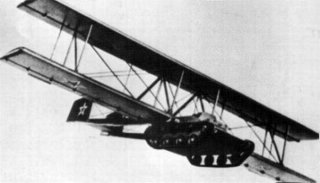Yes, That's a Flying Tank
What if a tank could fly onto a battlefield with a crew inside? This was a question that Oleg Antonov, the famed airplane designer of post-World War II fame tried to answer.
Here's What You Need To Remember: On the A-40’s one and only trip, the mothership had to ditch the glider, as the tank produced a large amount of drag, which cased the mothership’s engines to overheat. The tank and pilot driver apparently landed safely, shed the wings, and drove back to base.
Getting men and arms onto battlefields is a problem as old as warfare itself. In 1942, Soviet engineers tried to tackle this problem—by making a tank fly.
It’s a Bird, It’s a Plane, It’s a…Tank?
Paratroops in particular struggle to get armor into the fight. Though some tanks can be airdropped onto battlefields (like the interesting German tankette, the Weisel), they are generally too heavy to be dropped via parachute in the way that soldiers can be.
The other serious drawback to dropping armor out of airplanes is that their crews generally do not ride inside the armored vehicles but have to be either dropped separately or be already on the ground. Either way, rendezvousing with tanks could sometimes be a matter of luck rather than skill.
But what if a tank could fly onto a battlefield with a crew inside? This was a question that Oleg Antonov, the famed airplane designer of post-World War II fame tried to answer. To that end, he combined a tank with a glider, creating the Antonov A-40.
A-40
The A-40 was essentially a T-60 light tank that was equipped with wood and canvas wings arranged in an unusual biplane glider configuration with a double boom tail. This design was feasible only due to the nature of the T-60 itself—it was lightly armed and armored and was among the lighter of the Soviet Union’s tankettes.
In order to lighten the tank as much as possible for flight, some ammunition, the majority of its fuel, and parts of its armor was removed. Combined with its exposed underbelly during flight, the A-40 would be unlikely to put up much of a fight once it landed.
Since the A-40 was a glider and did not have a propeller for powered flight, it would be towed into battle by a mothership, a heavy transport plane.
In this configuration, the tank essentially served as the glider’s landing gear. When landing, the engine would be turned on, and the driver would gun the engines, getting the treads up to speed before landing, which would theoretically allow the A-40 to speed into battle.
The small tankette was armed with just one either 20 or 12.7 millimeter machine gun. The gun was operated by the tank’s commander, who also shared the cramped internal space with the driver who would serve as pilot when in the air.
One source states that the glider could be steered by rotating the turret for roll control, and by elevating the gun for elevator control, though this remains speculative.
On the A-40’s one and only trip, the mothership had to ditch the glider, as the tank produced a large amount of drag, which cased the mothership’s engines to overheat. The tank and pilot driver apparently landed safely, shed the wings, and drove back to base.
One Trick Pony
Despite the early success, the A-40 only made one flight, possibly because a more powerful mothership could not be found. Probably not so terrible considering how lightly armed and armored the A-40 was.
Caleb Larson holds a Master of Public Policy degree from the Willy Brandt School of Public Policy. He lives in Berlin and writes on U.S. and Russian foreign and defense policy, German politics, and culture. This article first appeared in April 2020.
Image: Wikimedia

